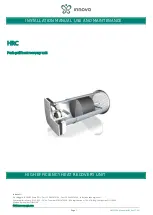
Manganese
0.0 ppm
0.0 ppm
pH Range (optimum rejection)
5.0 - 8.0
5.0 - 8.0
Turbidity
< 1.0 NTU
< 1.0 NTU
Silt Density Index
< 5.0 SDI
< 5.0 SDI
3.3 PRE-TREATMENT
For the TV-6000 and TV-8000 systems a 2.5” x 20” carbon block filter in the system frame filter
housing will not be practical for proper de-chlorination of the feed water supply. The high rate of feed
flow will deplete the 20” cartridge in a very short time. To properly de-chlorinate the water supply
feeding the TF membranes; an adequate capacity granular activated carbon (GAC) back-washing
filter should be used. Similarly, if the feed water contains any appreciable level of turbidity or par-
ticulate fines, a separate backwashing media (typically sand) filter should be installed ahead of the
TV system.
4.0 INSTALLATION
PLEASE READ CAREFULLY. FAILURE TO FOLLOW THESE PROCEDURES CAN RESULT IN
DAMAGE TO YOUR SYSTEM AND VOID YOUR WARRANTY.
4.1 LOCATION
It is recommended that systems be located where they are protected from harsh environments such
as rain, snow and extreme temperatures (both hot and cold). The TV-Series is intended for indoor
installation. TV-Series systems can be located just about anywhere inside where there are water
and electrical supplies and a drain for the brine discharge. Keep in mind, however, that they should
be out of normal traffic patterns but easily accessed for daily monitoring and service. The hazards
of flooding in the event of system failure should also be considered in the location selection.
4.2 PLUMBING
(see Figure 2)
Always adhere to local plumbing codes when installing the system. When installation procedures
conflict with your local plumbing codes, STOP and contact your dealer or Tomar.
Connect a feed water supply line to the pre-filter inlet (the filter is 3/4” fnpt on the left side).
The product and drain line connections are ½” tube QC fittings at the lower rear of the unit and they
are so marked. Connect 1/2” OD tubing at these ports.
4.2.1 WATER SUPPLY CONNECTION
If the supply water is being drawn from a non-pressurized tank, a boost pump will be required to
overcome filter backpressure and maintain about 25 psi (1.7 bar) to the pump. When the RO starts
there will be a momentary drop in feed water pressure. During this start-up, if the source feed
water system can not maintain a pressure above the cutout pressure of the low pressure switch (12
psi), the following options are possible:
1)
If the pressure drop is not more than, say, 6 psi below the 12 psi factory setting, the low
pressure switch setting can be lowered. (See 7.1 LOW PRESSURE SWITCH ADJUSTMENT)
2)
A 10-gallon bladder tank can be added at the feed filter inlet to help hold the pressure from
dropping below the cutout setting of the LP switch. The bladder tank also reduces recovery time. If
the feed pressure drops below the cutout point and can not recover to at least 22 psi quickly the use
of the tank will not help.
3)
The following should only be used as a last resort since it results in added cycling on and off
of the RO system. Usage is indicated when the unit is able to start normally; then during operation
13
Summary of Contents for TV-6000
Page 2: ...TOMAR TV 6000 SYSTEM ...
Page 7: ...Figure 1 Typical System Configuration TV 12K shown 5 ...
Page 13: ...Figure 2 System Plumbing Diagram 11 ...
Page 14: ...Figure 3 System Electrical Schematic Diagram ...
Page 20: ...Figure 4 PVC Vessel Membrane Assembly 18 ...
Page 21: ...Figure 5 Stainless Steel Vessel Membrane Assembly 19 ...
Page 28: ...25 NOTES ...
Page 31: ......
















































